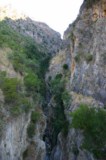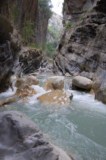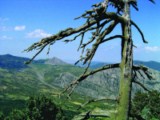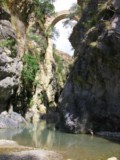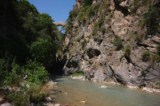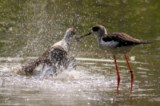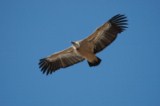|
RAGANELLO RIVER AND CANYON - CALABRIA- SOUTH ITALY The Raganello Canyon. A terrytory characterized by the Gole of the Raganello (gorges), that ends at the Ponte del Diavolo in Civita.
The Raganello Canyon is only part of a wonderfull Raganello Valley, a territory that takes the form of a large "S" that rotates around the homonymous river and covers part of the Pollino National Park. The Canyon is preceeded the Alta Valle del Raganello, that starts from the two main springs, covers the mountains until the confluence with the Maddalena torrent and the Gole del Barile. It is a mixed landscape with large forests, mainly beech, naturalized after the large deforestation at the beginning of the past century. Today, this landscape is even more valuable because it is catching up its original wilderness thanks also to low presence of man and its history until our days. The valley as we see it today is certainly the product of centuries of the work of man: the water of the water, to the terracing of the fields, to the recovery of spaces for grazing, so as to the work of thousands of men who have made it a valley, rich of agriculture products (renowned one time, the potatoes of Bellizia) to satisfaction of whole communities. Today the Valley is more silent. There are more the large farms with tens of workers, there is no longer the continuous voices of animals, men and women. There are very few men, mostly elderly, which graze sheeps, goats and cows. In this way the valley is changing aspect. Perhaps is catching up the ancient form, thanks to the work of the river Raganello incessant and all its tributaries, which left uncontrolled, are regaining old routes with may bring serious consequences from the hydro geological point of view. Whole areas of land, once cultivated with wheat, today seem to "float" waiting for the next flood that will bring them away. In the final analysis, it is reversing all the work of man, even the most recent in 1980s, and soon all towns under the valley may would face the consequences in terms of floods and landslides. The third piece of territory folowing the Raganello Canyon is the Fiumara Raganello, which starts from Civita and ends at the mouth in the Ionian Sea. The Fiumara Raganello is the classic route of outflow of a water course from very steep mountains; often these a very wide river beds eroded by strong floods that transport large amount of shingle materials. In these cases the river has created real and spectacular sandstone walls rich of colors. These environments are animal refuges of considerable importance. From the mouth of Raganello where you can meet flamingos, Black winged Stilts, Cranes; Going up the river meet Grey Herons, Ospreys and many other animals that find a home and food between the fallen stones and rocks. Instead, in the central part of the Raganello Canyon, you can find the peregrine falcon, the buzzard or the majestic Griffon Vulture recently reintroduced through a project of the Ministry of the Environment. The highest part is instead the reign of the Golden Eagle. |
||||||||



